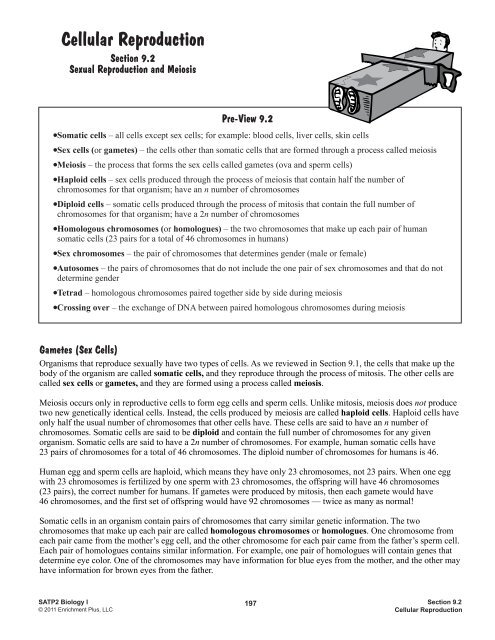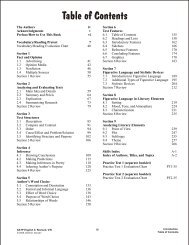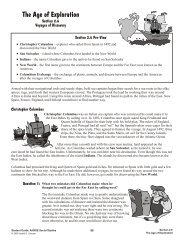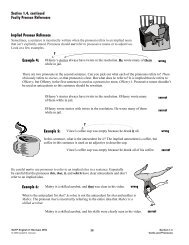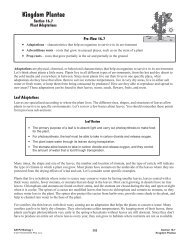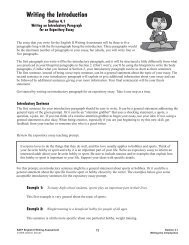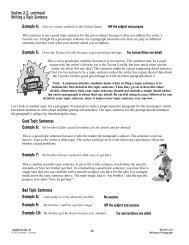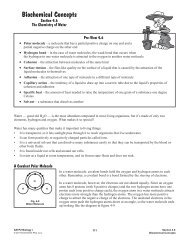Mississippi SATP2 Biology I Student Review Guide - Enrichment Plus
Mississippi SATP2 Biology I Student Review Guide - Enrichment Plus
Mississippi SATP2 Biology I Student Review Guide - Enrichment Plus
You also want an ePaper? Increase the reach of your titles
YUMPU automatically turns print PDFs into web optimized ePapers that Google loves.
Cellular Reproduction<br />
Section 9.2<br />
Sexual Reproduction and Meiosis<br />
Pre-View 9.2<br />
! Somatic cells – all cells except sex cells; for example: blood cells, liver cells, skin cells<br />
!Sex cells (or gametes) – the cells other than somatic cells that are formed through a process called meiosis<br />
!Meiosis – the process that forms the sex cells called gametes (ova and sperm cells)<br />
!Haploid cells – sex cells produced through the process of meiosis that contain half the number of<br />
chromosomes for that organism; have an n number of chromosomes<br />
!Diploid cells – somatic cells produced through the process of mitosis that contain the full number of<br />
chromosomes for that organism; have a 2n number of chromosomes<br />
!Homologous chromosomes (or homologues) – the two chromosomes that make up each pair of human<br />
somatic cells (23 pairs for a total of 46 chromosomes in humans)<br />
!Sex chromosomes – the pair of chromosomes that determines gender (male or female)<br />
!Autosomes – the pairs of chromosomes that do not include the one pair of sex chromosomes and that do not<br />
determine gender<br />
!Tetrad – homologous chromosomes paired together side by side during meiosis<br />
!Crossing over – the exchange of DNA between paired homologous chromosomes during meiosis<br />
Gametes (Sex Cells)<br />
Organisms that reproduce sexually have two types of cells. As we reviewed in Section 9.1, the cells that make up the<br />
body of the organism are called somatic cells, and they reproduce through the process of mitosis. The other cells are<br />
called sex cells or gametes, and they are formed using a process called meiosis.<br />
Meiosis occurs only in reproductive cells to form egg cells and sperm cells. Unlike mitosis, meiosis does not produce<br />
two new genetically identical cells. Instead, the cells produced by meiosis are called haploid cells. Haploid cells have<br />
only half the usual number of chromosomes that other cells have. These cells are said to have an n number of<br />
chromosomes. Somatic cells are said to be diploid and contain the full number of chromosomes for any given<br />
organism. Somatic cells are said to have a 2n number of chromosomes. For example, human somatic cells have<br />
23 pairs of chromosomes for a total of 46 chromosomes. The diploid number of chromosomes for humans is 46.<br />
Human egg and sperm cells are haploid, which means they have only 23 chromosomes, not 23 pairs. When one egg<br />
with 23 chromosomes is fertilized by one sperm with 23 chromosomes, the offspring will have 46 chromosomes<br />
(23 pairs), the correct number for humans. If gametes were produced by mitosis, then each gamete would have<br />
46 chromosomes, and the first set of offspring would have 92 chromosomes — twice as many as normal!<br />
Somatic cells in an organism contain pairs of chromosomes that carry similar genetic information. The two<br />
chromosomes that make up each pair are called homologous chromosomes or homologues. One chromosome from<br />
each pair came from the mother’s egg cell, and the other chromosome for each pair came from the father’s sperm cell.<br />
Each pair of homologues contains similar information. For example, one pair of homologues will contain genes that<br />
determine eye color. One of the chromosomes may have information for blue eyes from the mother, and the other may<br />
have information for brown eyes from the father.<br />
<strong>SATP2</strong> <strong>Biology</strong> I<br />
© 2011 <strong>Enrichment</strong> <strong>Plus</strong>, LLC<br />
197 Section 9.2<br />
Cellular Reproduction


